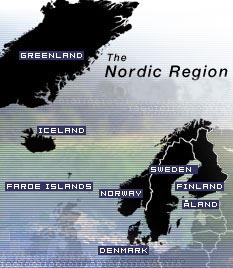Short introduction for foreigners

Nordic people
The Nordic countries are five sovereign states, Denmark, Finland, Iceland,
Norway and Sweden and three autonomous territories: the Faroe Islands and
Greenland (both Danish) and the Åland Islands (Finnish). These countries
have together about 23 million inhabitants, ranging from 250,000 in Iceland
to 8 million in Sweden. - In general, the term Nordic is used for
all five countries in this area, while the term Scandinavian,strichtly
speaking, refers to Denmark, Norway and Sweden.
Nordic languages
The Scandinavian languages Danish, Norwegian and Swedish are similar enough
for direct communication. Modern Icelandic and Faroese are more distant,
and Icelandic as well as Faroese people have to speak one of the Scandinavian
languages to be understood in other Nordic countries. Finnish is a Fenno-Ungrian
language and cannot be understood by Scandinavians. Finland has a Swedish-speaking
minority (approx. 6%) and Swedish is a compulsary subject in Finnish schools.
Thus communication within the Nordic community is mostly in Scandinavian
languages. In addition, the Greenlandic and Sami peoples have languages
of their own and/or own cultural traditions.
Nordic co-operation
"The region has has many variants of a common culture and many
interest groups. The Nordic people and their politically elected
representatives want to maintain this diversity. But they do have a common
basic philosophy and they wish to work together.
Nordic co-operation is not directed against anyone else. The region
simply wishes to show how independent states can forge a common future.
Nordic co-operation is unique in that it often goes on on an unofficial
basis, without red tape. Government agencies, local authorities,
institutions, and organizations in the Nordic countries can co-operate
directly with their Nordic counterparts at all levels. And they do.
Nordic co-operation is a matter of benefiting from one another
s knowledge and experience. Exchanges of information and views are
free and informal. Political parties, trade unions, interest groups,
and voluntary organizations find it perfectly natural to have Nordic umbrella
organizations and hold Nordic conferences at which to swap ideas. Nordic
co-operation is so natural and so diverse that we do not always realize
that it is unique."
(Quoted from a pamphlet published by The Nordic Council/The Nordic Council
of Ministers, 1991)
The Nordic flags

| Denmark |
Finland |
Iceland |
Norway |
Sweden |
Faroe islands |
Åland |
Greenland |
Sami |

